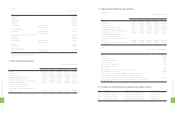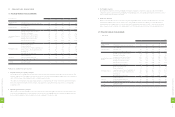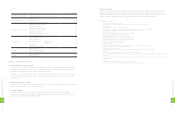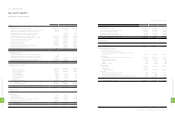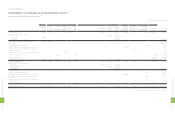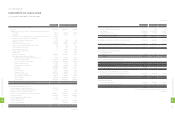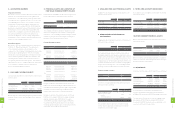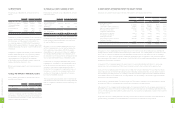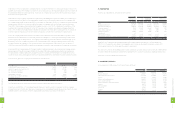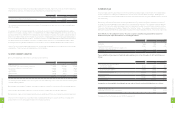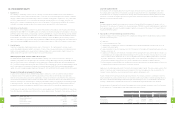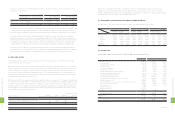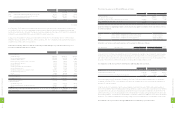HTC 2012 Annual Report Download - page 83
Download and view the complete annual report
Please find page 83 of the 2012 HTC annual report below. You can navigate through the pages in the report by either clicking on the pages listed below, or by using the keyword search tool below to find specific information within the annual report.
Fair value hedge
The gain or loss from remeasuring the hedging
instrument at fair value and the gain or loss on the
hedged item attributable to the hedged risk are
recognized in profit or loss.
Cash flow hedge
The portion of the gain or loss on the hedging
instrument that is determined to be an effective hedge
is recognized in stockholders' equity. The amount
recognized in stockholders' equity is recognized in
profit or loss in the same year or years during which
the hedged forecast transaction or an asset or liability
arising from the hedged forecast transaction affects
profit or loss. However, if all or a portion of a loss
recognized in stockholders' equity is not expected to
be recovered, the amount that is not expected to be
recovered is reclassified to profit or loss.
Hedge of a net investment in a foreign operation
The portion of the gain or loss on the hedging
instrument that is determined to be an effective hedge
is recognized in stockholders' equity. The amount
recognized in stockholders' equity is recognized in
profit or loss on disposal of the foreign operation.
(10) Financial Assets Carried at Cost
Investments in equity instruments with no quoted prices
in an active market and with fair values that cannot be
reliably measured, such as non-publicly traded stocks
and stocks traded in the Emerging Stock Market,
are measured at their original cost. The accounting
treatment for dividends on financial assets carried at cost
is the same as that for dividends on available-for-sale
financial assets. An impairment loss is recognized when
there is objective evidence that the asset is impaired. A
reversal of this impairment loss is disallowed.
(11) Investments Accounted for by the Equity Method
Investments in which the Company holds 20 percent
or more of the investees' voting shares or exercises
significant influence over the investees' operating and
financial policy decisions are accounted for by the
equity method.
The acquisition cost is allocated to the assets acquired
and liabilities assumed on the basis of their fair values
at the date of acquisition, and the acquisition cost in
excess of the fair value of the identifiable net assets
acquired is recognized as goodwill. Goodwill is not
amortized. The fair value of the net identifiable assets
acquired in excess of the acquisition cost is used
to reduce the fair value of each of the non-current
assets acquired (except for financial assets other than
investments accounted for by the equity method,
non-current assets held for sale, deferred income
tax assets, prepaid pension or other postretirement
benefit) in proportion to the respective fair values of
the non-current assets, with any excess recognized as
an extraordinary gain.
Profits from downstream transactions with an equity-
method investee are eliminated in proportion to the
Company's percentage of ownership in the investee;
however, if the Company has control over the investee,
all the profits are eliminated. Profits from upstream
transactions with an equity-method investee are
eliminated in proportion to the Company's percentage
of ownership in the investee.
When the Company subscribes for its investee's
newly issued shares at a percentage different from its
percentage of ownership in the investee, the Company
records the change in its equity in the investee's
net assets as an adjustment to investments, with a
corresponding amount credited or charged to capital
surplus. When the adjustment should be debited to
capital surplus, but the capital surplus arising from
long-term investments is insufficient, the shortage is
debited to retained earnings.
(12) Properties
Properties are stated at cost less accumulated
depreciation. Borrowing costs directly attributable
to the acquisition or construction of properties
are capitalized as part of the cost of those assets.
Major additions and improvements to properties are
capitalized, while costs of repairs and maintenance are
expensed currently.
Assets held under capital leases are initially recognized
as assets of the Company at the lower of their fair value
at the start of the lease or the present value of the
minimum lease payments; the corresponding liability
is included in the balance sheet as obligations under
capital leases. The interest included in lease payments
is expensed when paid.
Depreciation is provided on a straight-line basis over
estimated useful lives in accordance with the tax law
and regulations in the Republic of China: buildings
and structures (including auxiliary equipment) - 3
to 50 years; machinery, computer and equipment
- 3 to 5 years; furniture and fixtures - 3 to 5 years;
transportation equipment - 5 years; and leasehold
improvements - 3 years.
Revenue is measured at the fair value of the
consideration received or receivable and represents
amounts agreed between the Company and the
customers for goods sold in the normal course of
business, net of sales discounts and volume rebates.
For trade receivables due within one year from
the balance sheet date, as the nominal value of the
consideration to be received approximates its fair
value and transactions are frequent, fair value of the
consideration is not determined by discounting all
future receipts using an imputed rate of interest.
An allowance for doubtful accounts is provided on
the basis of a review of the collectability of accounts
receivable. This review is made by an aging analysis
of the outstanding receivables and assessing the
value of the collaterals provided by customers.
On January 1, 2011, the Company adopted the third-time
revised Statement of Financial Accounting Standards
("SFAS") No. 34 - "Financial Instruments: Recognition
and Measurement." One of the main revisions is that the
impairment of receivables originated by the Company
should be covered by SFAS No. 34. Accounts
receivable are assessed for impairment at the end of
each reporting period and considered impaired when
there is objective evidence that, as a result of one or
more events that occurred after the initial recognition of
the accounts receivable, the estimated future cash flows
of the asset have been affected. Objective evidence of
impairment could include:
• Significant financial diculty of the debtor;
• Accounts receivable becoming overdue; or
• It becoming probable that the debtor will undergo
bankruptcy or financial reorganization.
Accounts receivable that are assessed as not
impaired individually are further assessed for
impairment on a collective basis. Objective evidence
of impairment for a portfolio of accounts receivable
could include the Company's past experience of
collecting payments and an increase in the number of
delayed payments, as well as observable changes in
national or local economic conditions that correlate
with defaults on receivables.
The amount of impairment loss recognized is the
difference between the asset carrying amount and
the present value of estimated future cash flows,
after taking into account the related collaterals and
guarantees, discounted at the receivable's original
effective interest rate.
The carrying amount of the accounts receivable
is reduced through the use of an allowance
account. When accounts receivable are considered
uncollectible, they are written off against the allowance
account. Recoveries of amounts previously written
off are credited to the allowance account. Changes
in the carrying amount of the allowance account are
recognized as bad debt in profit or loss.
(7) Inventories
Inventories consist of raw materials, supplies, finished
goods and work-in-process and are stated at the lower
of cost or net realizable value. Inventory write-downs
are made by item, except where it may be appropriate
to group similar or related items. Net realizable value
is the estimated selling price of inventories less all
estimated costs of completion and costs necessary to
make the sale. Inventories are recorded at weighted-
average cost on the balance sheet date.
(8) Held-to-maturity Financial Assets
Held-to-maturity financial assets are carried at
amortized cost using the effective interest method.
Held-to-maturity financial assets are initially measured
at fair value plus transaction costs that are directly
attributable to the acquisition. Profit or loss is
recognized when the financial assets are derecognized,
impaired, or amortized. All regular way purchases or
sales of financial assets are accounted for using a trade
date basis.
An impairment loss is recognized when there is
objective evidence that the investment is impaired.
The impairment loss is reversed if an increase in
the investment's recoverable amount is due to an
event that occurred after the impairment loss was
recognized; however, the adjusted carrying amount of
the investment may not exceed the carrying amount
that would have been determined had no impairment
loss been recognized for the investment in prior years.
(9) Hedge Accounting
Derivatives that are designated and effective as
hedging instruments are measured at fair value, with
subsequent changes in fair value recognized either in
profit or loss, or in stockholders' equity, depending on
the nature of the hedging relationship.
Hedge accounting recognizes the offsetting effects
on profit or loss of changes in the fair values of the
hedging instrument and the hedged item as follows:
1
6
2
8
FINANCIAL INFORMATION
1
6
3
8
FINANCIAL INFORMATION


